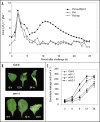Biphasic ethylene production during the hypersensitive response in Arabidopsis: a window into defense priming mechanisms?
- PMID: 19820330
- PMCID: PMC2710552
- DOI: 10.1104/pp.108.124404
Biphasic ethylene production during the hypersensitive response in Arabidopsis: a window into defense priming mechanisms?
Abstract
The hypersensitive response (HR) is a cell death phenomenon associated with localized resistance to pathogens. Biphasic patterns in the generation of H(2)O(2), salicylic acid and ethylene have been observed in tobacco during the early stages of the HR. These biphasic models reflect an initial elicitation by pathogen-associated molecular patterns followed by a second phase, induced by pathogen-encoded avirulence gene products. The first phase has been proposed to potentiate the second, to increase the efficacy of plant resistance to disease. This potentiation is comparable to the "priming" of plant defenses which is seen when plants display systemic resistance to disease. The events regulating the generation of the biphasic wave, or priming, remains obscure, however recently we demonstrated a key role for nitric oxide in this process in a HR occurring in tobacco. Here we use laser photoacoustic detection to demonstrate that biphasic ethylene production also occurs during a HR occurring in Arabidopsis. We suggest that ethylene emanation during the HR represents a ready means of visualising biphasic events during the HR and that exploiting the genomic resources offered by this model species will facilitate the development of a mechanistic understanding of potentiating/priming processes.
Figures


Comment on
-
Nitric oxide interacts with salicylate to regulate biphasic ethylene production during the hypersensitive response.Plant Physiol. 2008 Nov;148(3):1537-46. doi: 10.1104/pp.108.124404. Epub 2008 Sep 17. Plant Physiol. 2008. PMID: 18799663 Free PMC article.
References
-
- Mur LAJ, Kenton P, Lloyd AJ, Ougham H, Prats E. The hypersensitive response; the centenary is upon us but how much do we know? J Exp Bot. 2008;59:501–520. - PubMed
-
- Levine A, Tenhaken R, Dixon R, Lamb C. H2O2 from the oxidative burst orchestrates the plant hypersensitive disease resistance response. Cell. 1994;79:583–593. - PubMed
-
- Mur LAJ, Carver TLW, Prats E. NO way to live; the various roles of nitric oxide in plant-pathogen interactions. J Exp Bot. 2006;57:489–505. - PubMed
-
- Parker JE. Plant recognition of microbial patterns. Trends Plant Sci. 2003;8:245–247. - PubMed
-
- Lamb C, Dixon RA. The oxidative burst in plant disease resistance. Ann Rev Plant Physiol Plant Mol Biol. 1997;48:251–275. - PubMed
Publication types
LinkOut - more resources
Full Text Sources
